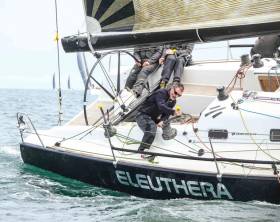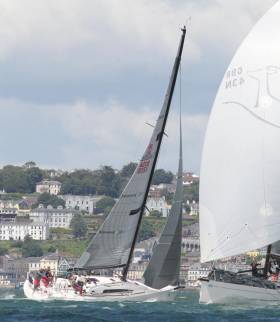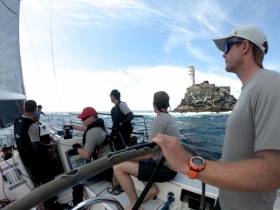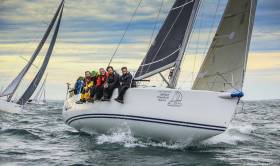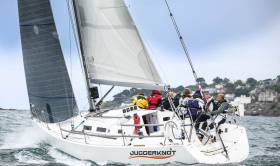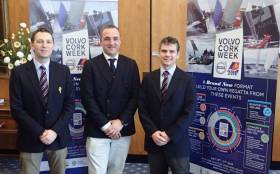Displaying items by tag: Cork Week
Great Turnout for Class Zero at Cork Week Regatta
Royal Cork Yacht Club's ability to attract a sizeable 'big boat' following for Volvo Cork Week is highlighted in today's Irish Times Sailing Column.
David O'Brien writes that the ten boat turnout assembled in Crosshaven for next week's regatta is nearly double what has been on offer so far this season.
For much more on the great turnout for Class Zero in Cork Harbour next week click here.
Volvo Cork Week - Aquatic Tourism Highlight in Cork Harbour
Over the 40 years of its history, Volvo Cork Week has cemented its reputation as a world-class sailing experience, flavoured with the key ingredients of friendly competition, varied sailing and excellent entertainment.
Cork County Council Chief Executive, Mr Tim Lucey said “Cork County Council through our Economic Development Fund is delighted to be a Platinum Sponsor of Volvo Cork Week 2018. I wish to congratulate The Royal Cork Yacht Club on organising this biennial sailing regatta based around Crosshaven and Cork Harbour. The strength and appeal of the Cork tourism offering are significant and this event provides an excellent opportunity to highlight what Cork has to offer.
"Volvo Cork Week runs, this year, from Sunday 15th to Saturday 21st July"
Cork County Council’s sponsorship will provide a platform to provide a direct Economic Impact to the Cork Region. Cork is the best place in Ireland to explore both of the best experiences in Ireland – Ireland’s Ancient East and the Wild Atlantic Way. Cork is truly a remarkable place with so much to do, see and experience. Go take a trip on the Dursey Island Cable Car, visit Mizen Head, Michael Collins House, Clonakilty, Spike Island, Cobh, Youghal Clock Gate Tower, Bridgetown Priory, Castletownroche, there is so much to do in our beautiful county.”
Mayor of the County of Cork Cllr. Patrick Gerard Murphy said “ I wish The Royal Cork Yacht Club every success for Volvo Cork Week 2018 and I look forward to attending events during the week. Volvo Cork Week has cemented its reputation as a world-class sailing experience and this can be seen in the number of entries to this year’s event. I would like to welcome all the visiting participants, families, and supporters to our great county and commend you all for the hard work, passion and dedication that has brought them here. While this is a competition, I wish to remind all participants, families and supporters to take some time to enjoy all that is “Pure Cork”.
“Cork is Ireland’s Maritime Haven with a significant maritime history spanning over a thousand years, set in a beautiful soft coastal environment where the land, the people, and their culture will allow you to discover a quirky way to stimulate all of your senses, have a look at Purecork.ie to make your own individual itinerary.”
Volvo continue their strong partnership with the sailing regatta in Crosshaven again this year. “Volvo Car Ireland are proud to continue their association with Volvo Cork Week 2018 for a third time. Together with Johnson & Perrott, we work to support what we see as important events in the communities where our customers live, work, and engage in sporting activities as a central part of their lives. At Volvo Cars, everything we do begins with people, from our commitment to safety to our innovative style.”
“The Volvo brand is evolving in Ireland and globally. Volvo has a strong heritage in designing stylish and dynamic SUVs offering the latest in technology and safety. The new XC40 is no exception. It’s the perfect car for an active lifestyle and our new range of cars will be on display at the regatta. May wind and sunshine continue, to delivery the racing conditions that this wonderful event deserves. Volvo wishes all competitors good luck for an enjoyable event on land and at sea in Crosshaven at Volvo Cork Week.” – David Thomas, Managing Director, Volvo Car Ireland.
Ireland’s Sailing Military Won’t Need a Soldier’s Wind for Top Performance in Beaufort Cup & Cork Week
Time was when “A Soldier’s Wind” was a slightly patronising term used to describe exceptionally favourable conditions for smooth voyaging in the great days of sail, with a beam reach in a good Force 4 being held up as the ideal writes W M Nixon
It dated from the era of government troopships criss-crossing the globe under sail when empire-building was in fashion, sailed by naval crews detailed with the job of getting military task-forces to operational hotspots as smoothly and quickly as possible.
It’s a term you’ll hear rarely used these days, if at all, as the growing need for troopships coincided with the arrival of steam- powered vessels which, while they were far from being luxury liners, were more efficient than sailing ships in this role.
So “A Soldier’s Wind” has been largely consigned to history and vague memory. And its disappearance from the Irish maritime vocabulary has been hastened by some remarkable sailing soldiers led by the likes of Commandant Barry Byrne, who has given us an entirely new perspective on military prowess in top flight racing boats.
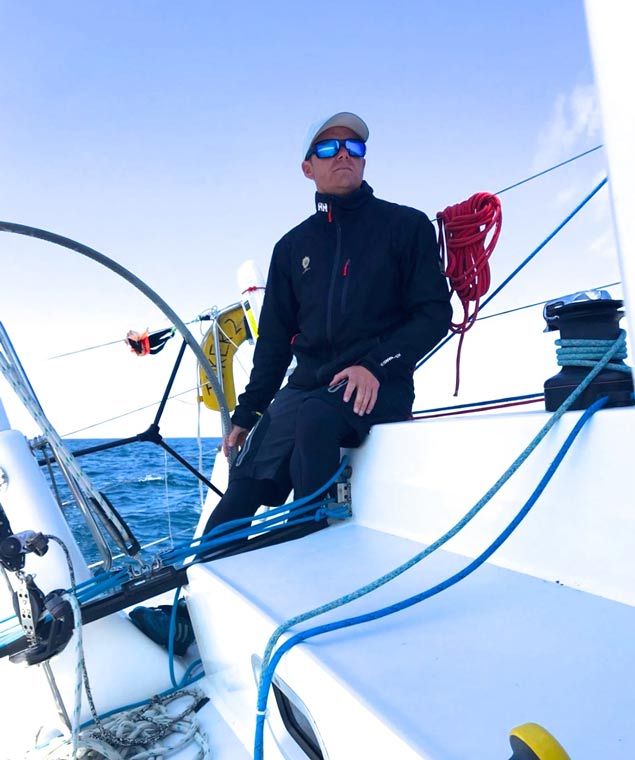 Barry Byrne at Joker II’s helm on Thursday July 5th, approaching the finish line at Wicklow to take second overall in the Round Ireland 2018, and clear first in the Services Division
Barry Byrne at Joker II’s helm on Thursday July 5th, approaching the finish line at Wicklow to take second overall in the Round Ireland 2018, and clear first in the Services Division
But although Barry Byrne has moved this military seafaring on to a new level of active involvement and command, Irish soldiers going in for offshore racing is nothing new. Way back in 1995, we did the Dun Laoghaire to Dingle Race with our hefty Contessa 35, and after a ding-dong nearly all the way with Jim Donegan of Cork with his Hustler 36 White Rooster (which he won, but we beat him the following year in the Round Ireland), we found ourselves berthed for one of the few times time alongside Dens Doyle’s mighty Frers 51 Moonduster, which had taken line honours and in time was the overall winner too.
It was intriguing to find Moonduster – which could carry a racing complement of up to 15 - was being crewed to a significant level by Army Cadets. One of Denis’s many sailing friends was the Irish army’s Colonel Barney Goulding. Having seen that Naval Cadets from the nearby base at Haulbowline in Cork Harbour did not necessarily work out when invited to join Moonduster’s enormous panel as potential crewmembers because they came aboard with too many pre-conceived ideas as to how a boat should be sailed and run, Barney suggested that he be allowed to give a squad of Army cadets a try.
It worked out very well at a high level of mutual respect, as the young army people were accustomed to working as a close team, they were extremely fit, and they were keen to learn while not claiming any deep knowledge of sailing. As for Denis, he just liked to get things done as quickly as possible with a minimum of fuss, and he was a main with absolutely no highfalutin airs or graces.
And the system worked very well indeed at a racing level– the convincing performance by Moonduster every which way in the Dingle Race proved it. At the time, many defence forces worldwide had long used sailing - particularly offshore sailing – as a useful adjunct to their training programme, often with a fleet of Navy-owned yachts to provide it. But in Ireland, as ever, we were to come to it in our own individualistic way.
 Denis Doyle’s Moonduster, brand new out of Crosshaven Boatyard in 1981. At first her large crew panel of 30 was mostly made up with Crosshaven sailors, but as they acquired boats of their own and fleet numbers grew generally, Moonduster used other sources including enthusiastic Army cadets to build fresh crews. Photo: W M Nixon
Denis Doyle’s Moonduster, brand new out of Crosshaven Boatyard in 1981. At first her large crew panel of 30 was mostly made up with Crosshaven sailors, but as they acquired boats of their own and fleet numbers grew generally, Moonduster used other sources including enthusiastic Army cadets to build fresh crews. Photo: W M Nixon
The Naval Service has a Yacht Squadron with its marina for officially-owned and private boats at their headquarters base at Haulbowline in Cork Harbour race, and sea training in craft of all sizes has been encouraged. But it all suddenly moved on to a new level in February 2016 when then Minister for Defence Simon Coveney suggested – or rather, gave firm instructions – that there should be an Inter-Services Challenge within the up-coming Volvo Cork Week 2016 in five months time.
It fell to a noted sailing soldier, Barry Byrne who originally emerged from that noted sailing nursery of Wicklow, to put together the structure of what became the Inter-Services Beaufort Cup, with a substantial entry and each boat (people were generous in making competitive craft available) carrying a crew which was made up of at least 50% services personnel, but in most cases the proportion was much higher than that.
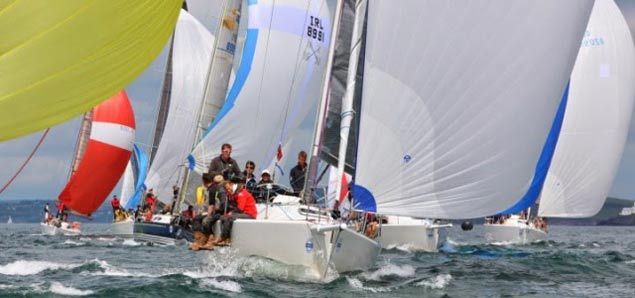 Racing under way for the inaugural Beaufort Cup Series, Volvo Cork Week 2016. Photo Robert Bateman
Racing under way for the inaugural Beaufort Cup Series, Volvo Cork Week 2016. Photo Robert Bateman
With a programme which included a separate race around the Fastnet yet also somehow incorporated the Beaufort Cup Series as part of Volvo Cork Week, its success exceeded all expectations, and the Irish Defence Forces Crew sailing the J/109 Joker II loaned by John Maybury of the Royal Irish YC on Dublin Bay, and skippered by Commandant Barry Byrne, had a popular overall win.
Suddenly, sailing was the hot ticket in military training thinking. Or so sailing enthusiasts liked to think. Certainly, we waited with some hopeful expectation to see what the powers-that-be might allow Barry Byrne to do next for the development of our sport in the broader context.
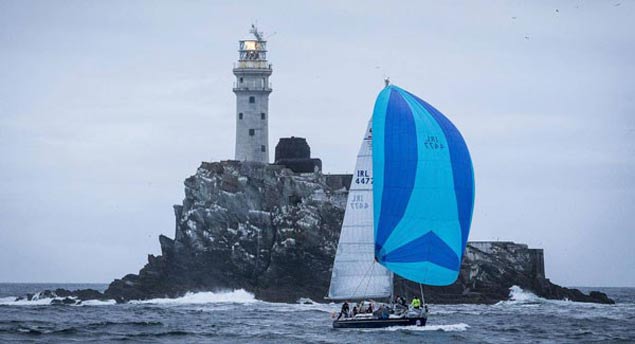 With the Fastnet Rock as the turning point for its offshore race, the Beaufort Cup added a new dimension to Cork Week
With the Fastnet Rock as the turning point for its offshore race, the Beaufort Cup added a new dimension to Cork Week
But the Army has a way of bringing everybody back to earth to remind us of its real purpose in life. Very quickly, the next item in the Barry Byrne military career was a six month tour of duty with the Irish contingent in the UN Peace-Keeping Forces in South Lebanon, based on the South West Headquarters as Deputy Director of the Tactical Operations Sector. Essential soldiering perhaps, but there’s not a lot of room for the development of sailing as an adjunct to military training in a dusty posting like that.
However, as all sailing now knows, Barry Byrne is very much back on the home scene again, with input to the second annual staging of the Beaufort Cup in Volvo Cork Week starting on Sunday July 15th. And meanwhile – also with Joker II – he and his Defence Forces crew have just had a magnificent Volvo Round Ireland Race, second overall and runaway winners of the Services Division.
But whether or not they’re going to be able to continue their run of success into the Beaufort Cup 2018 is another matter, for it has moved up several notches to become the glamour event of Cork Week, and there’s every indication that some crews will make full use of the rule that only 50% of their number be from the Service they represent.
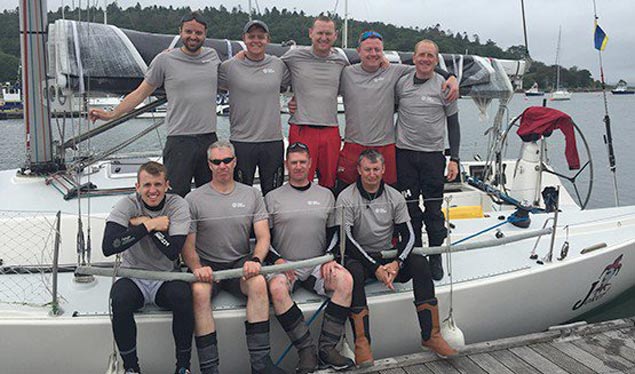 The winning Beaufort Cup crew, July 2016 – Barry Byrne second left, top.
The winning Beaufort Cup crew, July 2016 – Barry Byrne second left, top.
Even Barry Byrne himself is having to resort to some civilian support as one of his round Ireland crew sustained three fractured ribs during that sometimes decidedly rugged race, and while the casualty heroically carried on after being strapped up by his shipmates, doctor’s orders prohibit him from the demands of the Beaufort Cup.
So Joker II’s crew for this series is: Comdt. Barry Byrne, Sgt. Paddy McGrath, Lt Marcus Ryan, Lt Col Wayne Tyrell, Lt. Richie O’Hagan, Comdt. (Retd.) Ian Travers, Cpl. (Retd.) Brian Phelan, Brian Byrne, Malcolm Moir and Louis Malloy.
There are several in this lineup who shared in the success of 2016, but for 2018 there are 16 other high-powered entries for the Beaufort Cup determined to knock Joker II off her perch. They’re all seriously competitive craft, and with no less than eight J/109s in the Beaufort lineup, and with people of the calibre of Nin O’Leary, Tim Goodbody, Andrew Algeo, and Olympic coach Rory Fitzpatrick in various crew lineups, it could be anybody’s game.
Simon Coveney himself may now be Ireland’s Foreign Minister, but he’s no slouch on the sailing race course when he can find time to get afloat, and his name is associated with the Irish National Sailing Schools’ J/109 Jedi entry for the Beaufort Cup, while another name of note is solo sailor Joan Mulloy of Westport, whose Figaro 23 will be fully crewed up for this event.
 Historic and hospitable sailing paradise – looking northeast over Crosshaven and Cork Harbour
Historic and hospitable sailing paradise – looking northeast over Crosshaven and Cork Harbour
With the PSNI and Atlantic Youth Trust among those entered, the breadth of the competition is clearly in evidence as we also have crews from the Centenary-celebrating Royal Air Force, the Royal Navy, and the British Army’s Royal Engineers and Royal Signals, with a J/109 and an Elan 344 respectively.
Their programme will be stamina-testing afloat and ashore, as it includes that race round the Fastnet, following which there’s a Gala Dinner at Naval HQ in Haulbowline, and then they’ve somehow to find the energy to throw themselves into the concluding days of Volvo Cork Week itself, which will find Crosshaven humming.
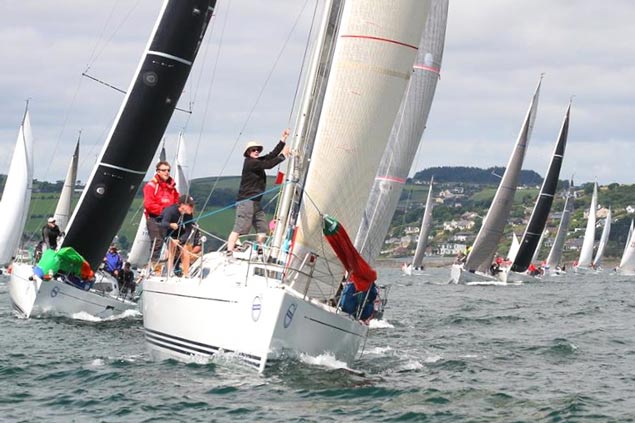 The magic moment of being first at the weather mark is even better in Volvo Cork Week.
The magic moment of being first at the weather mark is even better in Volvo Cork Week.
The Royal Cork Yacht Club sits comfortably in its role of the world’s senior yacht club approaching its Tricentenary, while at the same time being in harmony with its neighbourhood and community. This was much in evidence on the charming evening recently (it was appropriately Midsummmer’s Night) when international designer Ron Holland launched his memoirs, and explained how he first came to Crosshaven for a weekend in November 1973 to look into an enquiry from Hugh Coveney and sailmaker John McWilliam about a new boat design, and ended up staying in Ireland for forty years and building a global business.
 Crosshaven sailmaking pioneer Johnny McWilliam and RCYC Vice Admiral Colin Morehead. Photo Robert Bateman
Crosshaven sailmaking pioneer Johnny McWilliam and RCYC Vice Admiral Colin Morehead. Photo Robert Bateman
What with video presentations and personal memories in front of an audience of all ages, it could have been chaotic, but with Johnny McWilliam as MC and the RCYC’s CEO Gavin Deane in his usual efficient, unflappable, and obliging style, it was a historic evening of remarkable and entertaining memories which told us as much about the spirit of the Royal Cork as anything else.
Thus they take Volvo Cork Week in their stride, with Organising Committee Chairman Kieran O’Connell – he has been in the post since 2014 – knowing its complete workings inside and out, which is no easy achievement. For the expectations for Cork Week come laden with history, and the business of melding the Beaufort Cup and class championships for boats like the International Dragons, the SB20s and the 1720s into one big successful event doesn’t happen without special effort.
 Gavin Deane, CEO Royal Cork YC. Photo: Robert Bateman
Gavin Deane, CEO Royal Cork YC. Photo: Robert Bateman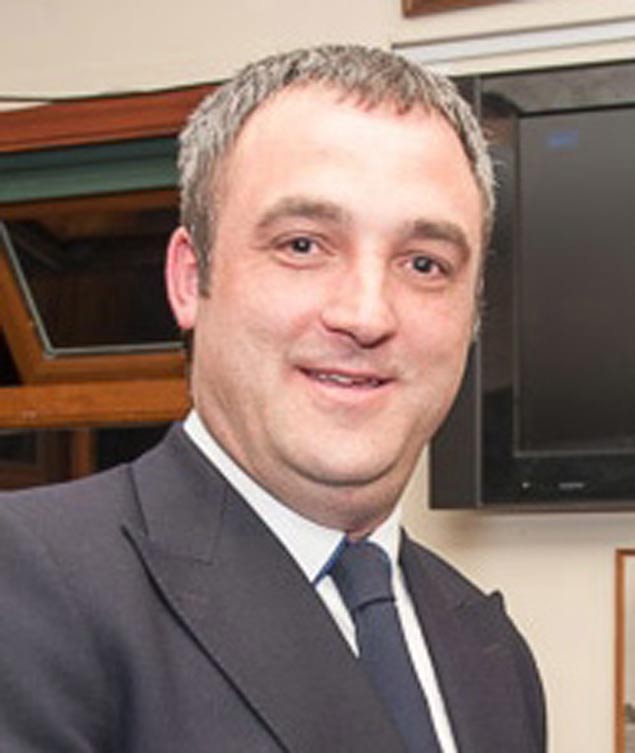 Kieran O’Connell, Chairman of Cork Week Organising Committee. Photo: Robert Bateman
Kieran O’Connell, Chairman of Cork Week Organising Committee. Photo: Robert Bateman
Cork Week as we know it goes back to 1978, when it was inaugurated by the then RCYC Admiral Archie O’Leary, who felt he could significantly improve on an ISORA Week which had been staged at Crosshaven in 1976, while there were also memories of a small-fleet mini-week in 1970 as part of the RCYC Quarter Millennial Celebrations, with the overall winner being Jack McKeown’s S&S 34 Korsar from the Royal St George YC in Dun Laoghaire.
But as the massive History of the Royal Cork Yacht Club published in 2005 confirmed, extended regattas often using coastal courses to take in Kinsale dated back to at least 1859, and the still-very-much-alive pure silver “Kinsale Kettle” trophy of that year is ample evidence of this. Yet while the distant history is there and must be respected, the continuing refinement of the programme with new ideas in Cork, and taking aboard ideas from the success of others, is a useful way to go.
For until now this has arguably been the best season for many years for regattas in Ireland, a reminder of what we can do when the weather is obliging. The endless sunshine and drought may be a very real problem ashore, with the nation rendered somnolent to the point of being comatose. But people are energised afloat in a summer which until this weekend last saw rain – and not much of it – on the first day of the Wave Regatta at Howth at the beginning of June. And that was followed by two days of so much sun that it obliterated any grey day memories, and set the pattern for the East Coast regattas.
 Is that hull black, or is it midnight blue? Either way, Scottish skipper Jonathan Anderson’s J/122E El Gran Senor got the better of Jamie McWilliam’s Ker 40 Signal 8 at last weekend’s Bangor Town Regatta on Belfast Lough, and is now on her way to Volvo Cork Week. Photo: Andrew Gallagher
Is that hull black, or is it midnight blue? Either way, Scottish skipper Jonathan Anderson’s J/122E El Gran Senor got the better of Jamie McWilliam’s Ker 40 Signal 8 at last weekend’s Bangor Town Regatta on Belfast Lough, and is now on her way to Volvo Cork Week. Photo: Andrew Gallagher
As the land continued to dry, the sea breezes behaved in sunny textbook style to give great sailing which could be brought to a close at the proper time for the shoreside festivities to get under way, and last weekend saw this happening in the one day Royal St George YC Regatta on Dublin Bay, and the three day Bangor Town Regatta on Belfast Lough hosted by Ballyholme YC and Royal Ulster YC.
Leading boats from both events have headed on for Cork, and noted podium craft from Bangor include veteran Scottish skipper Jonathan Anderson’s J/122E El Gran Senor which seems to be all black – sails and everything – and managed to win Class 0 against Jamie McWilliam’s Ker 40 Signal 8 on Belfast Lough, where another class winner was Rory Fekkes slippy little all black F’nGr8. She’s also due to take to the line in Cork, as will Jay Colville’s successful First 40 Forty Licks from Strangford Lough.
 Johnny Swann’s classic Half Tonner Harmony Photo: Afloat.ie
Johnny Swann’s classic Half Tonner Harmony Photo: Afloat.ie
From further down the East Coast, Johnny Swann’s classic timber-built Half Tonner Harmony out of Howth is also stepping up to the Crosshaven plate, while the West Coast – in addition to Joan Mulloy from Westport – has the ever-keen Liam Burke from Galway with the Farr 31 Tribal, and French interest is provided by Jean Francois Nouel from Pornic in Brittany with his Sun Fast 3200 Hakuna Matata, which at one stage was in the top three in last week’s Round Ireland, but had slipped by the finish.
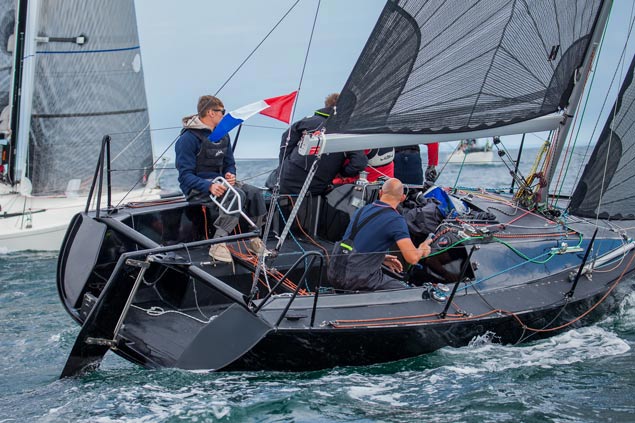 Rory Fekkes’ little black flyer Fn’Gr8 from Carrickfergus was once upon a time a sedate little Beneteau. Photo: Andrew Gallagher
Rory Fekkes’ little black flyer Fn’Gr8 from Carrickfergus was once upon a time a sedate little Beneteau. Photo: Andrew Gallagher
Another noted visitor is the J/109 Mojito from Pwllheli (Vicky Cox & Peter Dunlop), the 2017 ISORA Champion. She’ll be racing against an interesting turnout of J/109s, for when the eight boats of this popular type in the Beaufort Cup are added to the others in the Open Division, we’ve a round dozen of well-tuned J/109s waiting to do battle.
There’s also a dozen International Dragons taking part for their Southern Championship. Of late, Irish Dragons have been seen at Mediterranean venues as much as they’ve been seen at home, but when the Mediterranean came to Ireland, they’ve followed it here.
For the general success of Volvo Cork Week 2018, we can only hope that something like the Mediterranean returns us for another six days after this weekend’s blip, though it has to be said there are some potentially very restless conditions out in the Atlantic. But whatever the weather, the racing for the Beaufort Cup will be an absolute zinger. Denis Doyle and Barney Goulding will be very pleased.
I remember being part of a fleet of some 700 yachts, the sight of which, winding its way in a long parade out of Crosshaven every morning to the racing grounds, drew crowds to watch Cork Week.
Those days have gone and this year’s Cork Week, which will open on Sunday, has 110 boats, which is a 30 per cent increase on the number of yachts at the last event, in 2016.
The Chairman of Volvo Cork Week, Kieran O’Connell, who is also Rear Admiral Keelboats at the Royal Cork Yacht Club in Crosshaven which runs the event, takes a practical view of the changes, focussing the event on the quality of the racing: “They were different times, people were travelling more with their boats, but those days have gone when people could take time off work and leave the family and go racing for a week.”
He is pragmatic in recognising that the event had, back in those years, become like a rock festival rather than a sailing event “and I think a lot of people may have been annoyed by that format and it saw a very steep decline in the numbers attending the event over a very short period of time.”
"Cork Week will begin on Sunday with an Open Day for the public at the RCYC in Crosshaven"
The Royal Cork YC, says Kieran, prides itself on being a club of sailors which runs regattas for sailors and what happened was taken note of and changes made. “It might have taken a while, but we identified that and now have a format that is working for sailors and the increased interest shows that the changes are bringing back the interest in competitive racing. The feedback we are getting is that sailors like the format and the options for different levels of participation which are being given to them.”
In this week’s MacSweeney Podcast, Kieran O’Connell talks frankly about the changes in Cork Week and why they were made and also discusses the development of the club’s Under 25 Keelboat Academy, members of which will race two boats in the regatta.
Cork Week will begin on Sunday with an Open Day for the public at the RCYC in Crosshaven when the club is inviting people to come and see what it and sailing are all about.
Listen to the Podcast below:
Joker II, Commandant Barry Byrne's winning J109 entry from this Round Ireland Race will meet teams from the National Services and a US Marines team at the Beaufort Cup at Cork Week starting on July 15th.
The second ever Beaufort Cup, a race exclusively for teams associated with their national services, will take place at this year’s Volvo Cork Week. Hosted by The Royal Cork Yacht Club, the event invites services from Ireland, Europe and further afield, to compete for the Trophy. Defence Force Teams from a number of countries will compete and also other services such as Police, Fire, Rescue, RNLI and Coastguard service teams.
Following the huge success of the inaugural race in 2016, this year’s competition welcomes an American team made up of former marines and coast guards who were seriously injured while on service. The team of four includes Sgt Robert Aiken who began sailing through the initiative of the Warrior Sailing Program, providing maritime education and outreach for wounded, ill and injured service members and veterans organised by the US Merchant Marine Academy. “I’m very thankful to the wonderful donors and staff for recognising the therapeutic value sailing has to offer those of us adjusting to new circumstances - both physical and emotional” said Sgt Aiken.
The rest of this very exceptional team includes Brett Linville, Sergeant in United States Marine Corps for 8 years. Conducting combat missions in western Iraq between 2005-2006 as a machine gunner and team leader of 8 other gunners during various operations, Sgt Linville sustained a back injury from a fall during a mortar attack. Accrediting many attributes to the values instilled in him through the Marine Corps, he will also share a boat with Dawn Hart who has spent 12 years in the US Coast Guard. Having come on the racing scene in the US she says she has enjoyed “sailing and competing in regattas and taking advantage of as many opportunities as possible. I thought this was an amazing opportunity and an experience in which I could learn from other sailors.”
This event develops valuable bonds between national team members and international colleagues alike, through a competitive, but also very sociable, event. The Beaufort Cup represents a fantastic opportunity to strengthen international ties through offshore sailing and closely fought inshore racing in the natural maritime amphitheatre that is Cork Harbour.
“The Beaufort Cup invites sailing teams from their associated national services, 50% of each team must be active in the service they represent. Racing will take place over five days in a mix of challenging offshore and tactical inshore racing. Teams will get the chance to enjoy the renowned social experience of Volvo Cork Week and the winning team will have €10,000 donated to a nominated charity of their choice while the winner will also be eligible for the ‘Boat of the Week’ prize at Volvo Cork Week 2018” says Kieran O’Connell, Chairman of Volvo Cork Week.
With 110 boats already entered, Volvo Cork Week is preparing to welcome crews and boats from all over Ireland, the UK and from as far away as Dubai, Australia and Hong Kong. With a new flexible format of racing available to participants, competitors can choose to race for the full five days, three days or contestants can hold their own class championships, finishing on the Saturday. It’s an exciting amendment that has attracted a diverse demographic from many sectors of the sailing world. It also allows competitors to enjoy the outstanding entertainment once ashore.
At The Royal Cork Yacht Club, there are fun packed family events such as treasure hunts, face painting and kids games on Sunday,15th and Saturday, 21st July, kicking off at 11am.
At the Opening Ceremony on 15th July, there is live music from easy listening crooner, The Loungeman, who returns for the Ladies Fashion Show and Lunch on Wednesday 18th July. Every night of the week there is world class music and entertainment following the races and Gala Dinners, including The Roaring Forties, Midnight Sons and Amazing Apples as well as late night DJs throughout the weekend.
Online entry is still open and the closing date is 30th June.
Event and Entertainment Timetable Volvo Cork Week Race Week Timetable
|
Sunday 15th July |
Sunday 15th July |
|
Monday 16th July |
Monday 16th July |
|
Tuesday 17th July |
Tuesday 17th July |
|
Wednesday 18th July |
Wednesday 18th July |
|
Thursday 19th July |
Thursday 19th July |
|
Friday 20th July |
Friday 20th July |
|
Saturday 21st July |
Saturday 21st July |
Royal Cork's 'Beaufort Cup' Teams Seek More Boats, 20 Entered So Far Including Eight J109s
After the success of the inaugural Beaufort Cup for Military and Emergency teams in 2016, this year's entries are approaching 20 boats already, including no less than eight J109's for the Cork Week event. There's an excellent line up of Dublin and Cork boats now involved and organisers are appealing for further Irish boats owners to team up with Services teams.
Fancy entering Volvo Cork Week for free? Joining an exciting new fleet, having a chance to win €10,000 prize money and getting some experienced crew to help race your yacht? Maybe the Beaufort Cup is the event for you...?
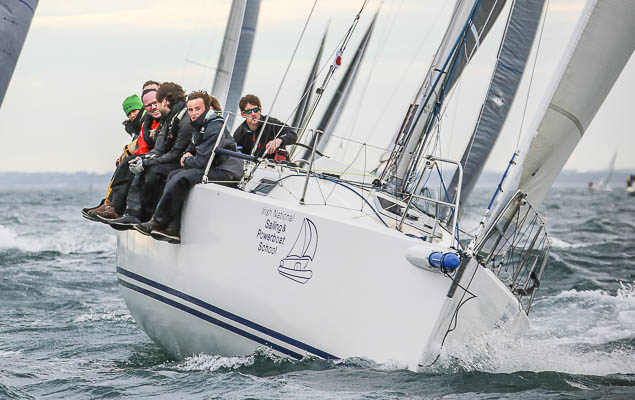 Tanaiste Simon Coveney has entered the Dublin-based INSS J109 for the Beaufort Cup. Photo: Afloat.ie
Tanaiste Simon Coveney has entered the Dublin-based INSS J109 for the Beaufort Cup. Photo: Afloat.ie
The Beaufort Cup is an international sailing event, run as part of Volvo Cork Week for military and emergency service teams. Beaufort Cup teams also have the opportunity to participate in the full sailing programme for the week.
"There are currently a number of teams looking to team up with Irish boats"
Only 50% of the team must be from the service they are representing, and there are currently a number of teams looking to team up with Irish boats.
So what's in it for you?
Free entry to Volvo Cork Week, the possibility to team up with a military or emergency services crew, join us at the Beaufort Bar in the tented village at Volvo Cork Week, which will have exclusive parties throughout the week, the unique opportunity to attend the Beaufort Cup Gala dinner on Haulbowline Island Naval Base, €10,000 prize money for the charity of your choice, plus the now famous short offshore; a 24hr race from Cork Harbour to the iconic Fastnet Rock and back.
Asked what the lure of this event is, 2016's winner Commandant Barry Byrne said that "the unique atmosphere and camaraderie between the services teams in the fleet is something the yacht owners really enjoy being a part of, also the short offshore is the perfect length; 24 hours down to the Fasnet along some of the most scenic coastline in the world is a great feature of the event, last time we had nine boats all rounding the rock within an hour of each other."
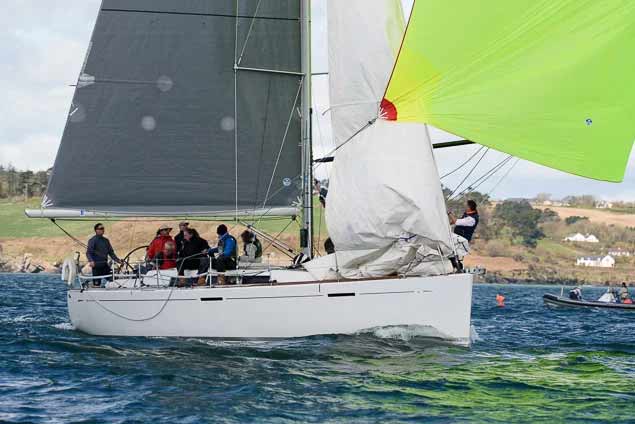 Denis Murphy's Grand Soleil 40 Nieulargo will race as RNLI Crosshaven in the Beaufort Cup. Photo: Afloat.ie
Denis Murphy's Grand Soleil 40 Nieulargo will race as RNLI Crosshaven in the Beaufort Cup. Photo: Afloat.ie
For J109 owners in particular, the possibility to join this fleet and compete against another eight J109s, from the Royal Navy, Royal Engineers, Royal Air Force, Irish Defence Forces and a myriad of other teams, is very appealing.
While there is a large fun element to the competition, and lots of friendly rivalry between the services, there is also very serious racing at the top end of the fleet. This year's fleet has attracted some high profile racing names, such as Irish past All Ireland champions Peter O'Leary and Stephan Hyde.
See the full 2018 Cork Week and Beaufort Cup entry list here
There are currently a number of highly experienced international and national teams looking to team up with Irish boats, if you are interested in getting involved, contact Barry Byrne at [email protected] or James Fegan at [email protected]
Cork Week to Welcome Welsh Police Force, Royal Air Force, Royal Engineers & Royal Navy
The UK Launch of Volvo Cork Week 2018 was held at the Royal Southern Yacht Club in Hamble, with an after party at the King & Queen Pub. Representing Volvo Cork Week was Director of Racing Rosscoe Deasy, Event Chairman Kieran O’Connell, and Gavin Deane General Manager of the Royal Cork Yacht Club. This July, Volvo Cork Week welcomes a wide variety of international sailors to experience well-managed racing on a range of courses, both inside and outside of Cork Harbour. Classes will include IRC rated boats, non-spinnaker, 1720, Dragons and Sportsboats. 1st of May is the early bird deadline.
“Entries for Volvo Cork Week are coming in well above last year's quota from Irish competitors, and the UK launch was all about informing and encouraging British teams to come and compete.” commented Kieran O’Connell. “We are delighted to hear that the Royal Southern YC will be forming a youth team for Volvo Cork Week, and we are delighted to welcome more teams from overseas to enjoy the hospitality of the Royal Cork YC this July. The new format allows a huge variety of sailors and boats to attend, with events ranging from a full week of racing to just a single day, there is a style of racing to suit just about everyone.”
The second edition of the Beaufort Cup will take place during Volvo Cork Week 2018. International teams from their associated national services will take part, 50% of each team must be active in the service they represent. Racing is scheduled over five days with a mix of challenging offshore, and tactical inshore racing, including a Fastnet Rock Race. Teams will be able to join in the shoreside fun at Volvo Cork Week and their own Gala Dinner. The winning team will have €10,000 donated to their nominated charity.
“We have already got a lot of entries from the UK and one from France including the Welsh Police Force, Royal Air Force, Royal Engineers, and Royal Navy. Three teams will compete from the Irish Defence Forces and we have interest from two RNLI stations, Crosshaven and Baltimore. We would welcome entries from other services, and right now we have owners who have made boats and crew available for the Beaufort Cup and we would be delighted to put them both together. We hope to get in excess of 20 entries.” commented Chair of the Beaufort Cup, James Fegan.
UK Launch of Volvo Cork Week 2018 on St Patrick’s Day
For 40 years Volvo Cork Week has welcomed teams from overseas to the biennial regatta hosted by the Royal Cork Yacht Club in Crosshaven, and what better time than Patrick's Day for the UK Launch of Volvo Cork Week 2018.
Senior members of the organising committee for Volvo Cork Week will be in attendance for two events in Hamble, which just happens to coincide with the England versus Ireland Six Nations Rugby and Grand Slam decider and St Patrick's Day.
Representing Volvo Cork Week in Hamble will be Volvo Cork Week Director of Racing, Rosscoe Deasy, Event Chairman Kieran O'Connell, and Gavin Deane, General Manager of the Royal Cork Yacht Club.
An Tánaiste, Simon Coveney, TD, launched, Volvo Cork Week, today on Haulbowline Island in Cork Harbour, following the cancellation of the original launch last Friday due to the arrival of Storm Emma.
Royal Cork Yacht Club has reconfigured its biennial regatta with a number of novel new features. The event takes place this year in Crosshaven from July 16th to July 21st.
Speaking at the launch Minister Coveney said: “It is always a pleasure to be asked to officially launch an event like Volvo Cork Week. Events like this are very important for Ireland, showcasing, as they do, the beautiful marine resource we have, particularly here in Cork Harbour, the second biggest natural harbour in the world. Competition for The Beaufort Cup will see teams from many different national and international defence forces, RNLI, Coast Guard, Welsh and Northern Ireland Police, and other service teams, competing against each other and this year it again includes an overnight race around the famous Fastnet Rock. It is great to see Volvo Cork Week being the first Irish Regatta to take an active approach on the fight against plastics. It is a subject that is very close to my heart and I will do all I can to assist them in their effort this year. Cork is truly at the forefront of sustainability and renewable energy, with MaREI (Centre for Marine and Renewable Energy) located here in Cork Harbour.”
All photos by Bob Bateman
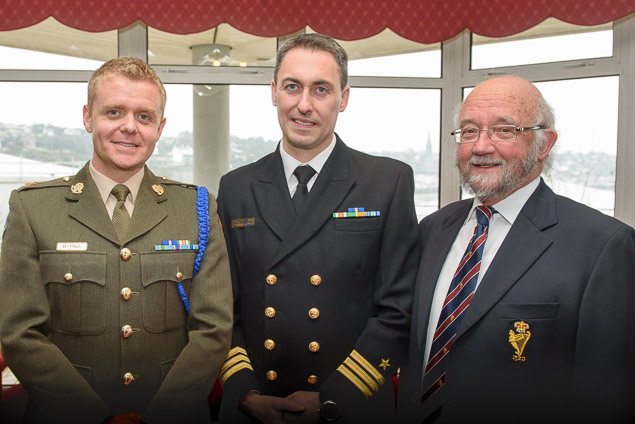 2016 Beaufort Cup winner, Commandant Barry Byrne, Commander Brian Matthews and Pat Harte, Hon Secretary of Royal Cork
2016 Beaufort Cup winner, Commandant Barry Byrne, Commander Brian Matthews and Pat Harte, Hon Secretary of Royal Cork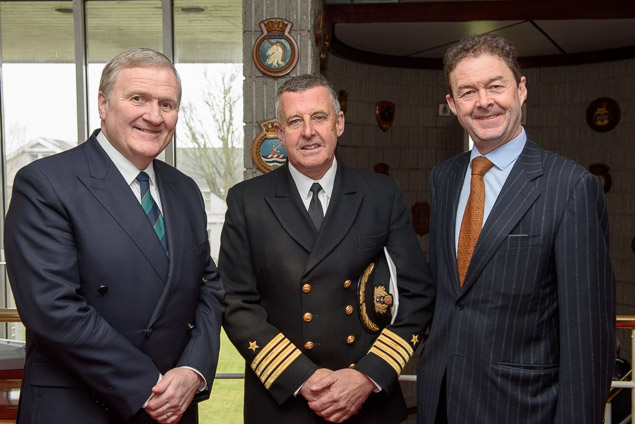 Irish Sailing President Jack Roy with Captain William Roberts and David Thomas of Volvo
Irish Sailing President Jack Roy with Captain William Roberts and David Thomas of Volvo  Captain William Roberts, Jack Roy,, Pat Farnan and Darragh Connolly
Captain William Roberts, Jack Roy,, Pat Farnan and Darragh Connolly Captain William Roberts, Mayor of Cork County Cllr Declan Hurley, Deputy Mayor Kieran McCarthy and David Thomas
Captain William Roberts, Mayor of Cork County Cllr Declan Hurley, Deputy Mayor Kieran McCarthy and David Thomas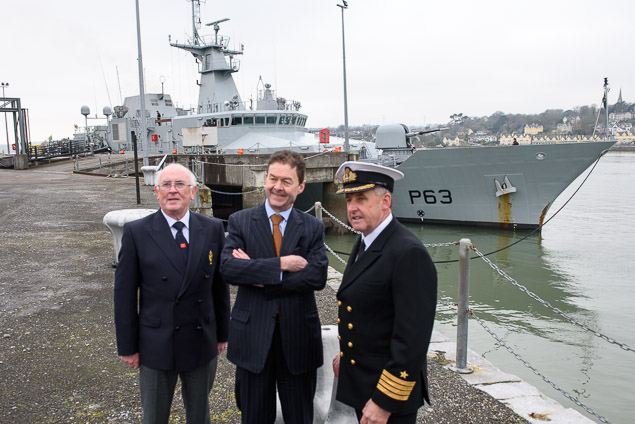 Pat Farnan, David Thomas and Captain William Roberts in front of the Irish Navy Ship, LE William Butler Yeats
Pat Farnan, David Thomas and Captain William Roberts in front of the Irish Navy Ship, LE William Butler Yeats RCYC Admiral Pat Farnan addresses the gathering on Haulbowline Island
RCYC Admiral Pat Farnan addresses the gathering on Haulbowline Island Jack Roy of Irish Sailing
Jack Roy of Irish Sailing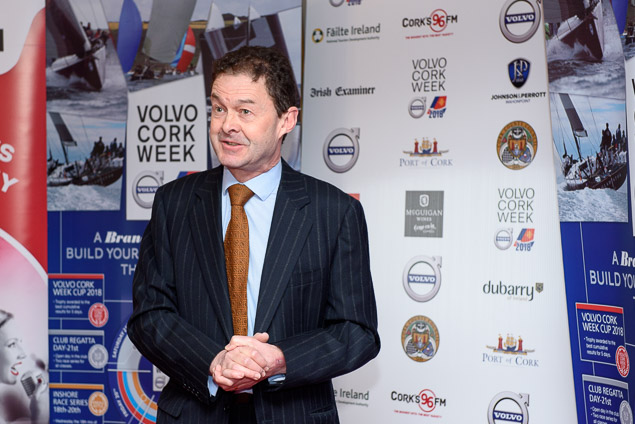 David Thomas of Volvo
David Thomas of Volvo An Tánaiste Simon Coveney
An Tánaiste Simon Coveney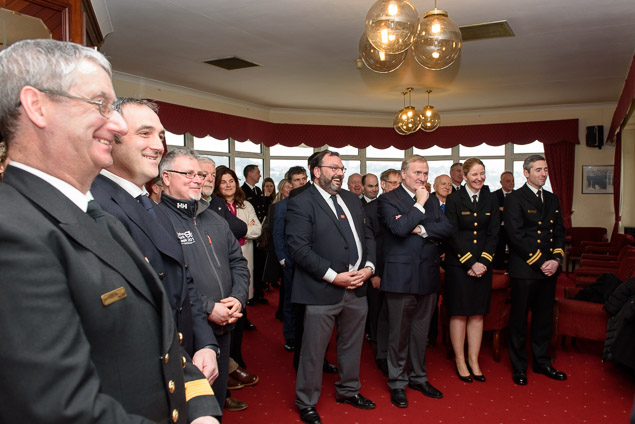 A great turnout at Haulbowline
A great turnout at Haulbowline Cork Week Chairman Kieran O'Connell, with Jack Roy (who will be the event's Chief Race Officer) Admiral Pat Farnan and Cove Sailing Club's Joannna Murphy
Cork Week Chairman Kieran O'Connell, with Jack Roy (who will be the event's Chief Race Officer) Admiral Pat Farnan and Cove Sailing Club's Joannna Murphy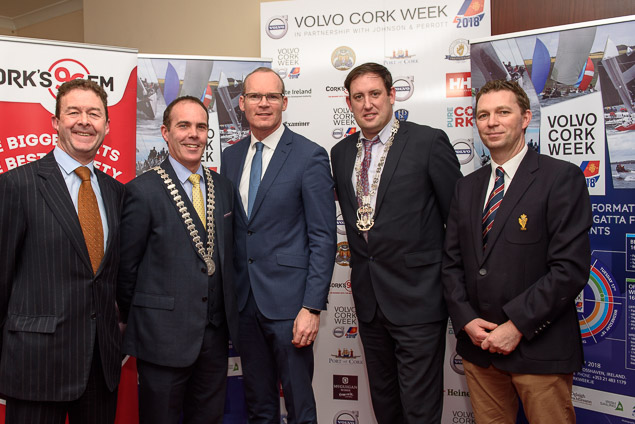 Volvo's David Thomas, Mayor of Cork County Cllr Declan Hurley, An Tanaiste Simon Coveney, Deputy Mayor Kieran McCarthy and Royal Cork CEO Gavin Deane
Volvo's David Thomas, Mayor of Cork County Cllr Declan Hurley, An Tanaiste Simon Coveney, Deputy Mayor Kieran McCarthy and Royal Cork CEO Gavin Deane Royal Cork's Ross Deasy with Commander Brian Matthews and Royal Cork's Darragh Connolly
Royal Cork's Ross Deasy with Commander Brian Matthews and Royal Cork's Darragh Connolly (From right) Cork Week Chairman Kieran O'Connell, with Volvo's David Thomas and An Tanaiste Simon Coveney
(From right) Cork Week Chairman Kieran O'Connell, with Volvo's David Thomas and An Tanaiste Simon Coveney
David Thomas, MD Volvo Car Ireland, said that Volvo Car Ireland, in partnership with Johnson & Perrott, are proud to sponsor Volvo Cork Week for the third time: "since coming to Ireland, I have seen and appreciate the importance of the water as an island nation. The Volvo brand is synonymous with sailing across the world and we believe in the importance of supporting, and partnering, with sports and communities where our customers live, work, and play."
Kieran O’Connell, Chair of Volvo Cork Week, welcomes the growing awareness of the plastics issue amongst the public and particularly amongst sailors. He intends to put an emphasis on reducing Volvo Cork Week’s impact on the environment. Amongst the initiatives being proposed is that all competitors will be asked to use reusable drink containers and there will be water coolers/fountains available. Suppliers will be asked to reduce their use of plastic and use compostable materials. “Each year, 8 million tonnes of plastic enters our seas and if no action is taken there will be more plastic than fish in the ocean by 2050, every bit of plastic ever made still exists somewhere. Care to the environment is a core value at Volvo Car Ireland and we intend to play our part during Volvo Cork Week 2018. Education and outreach activities will be facilitated by MaREI during the event."
The first of a series of beach clean ups took place during the launch. Schoolchildren from Crosshaven took part in an initial clean up of the beach on Haulbowline Island. This is the first in a series of nationwide beach clean ups Volvo have planned to help raise awareness of the #TurnTheTideOnPlastics initiative.
The Royal Cork Yacht Club is the NMU Marina of the Year and is a Gold Anchor Awardee from the Yacht Harbour Association. It is committed to minimising the impact of its activities on the environment and has created a Green Events Policy which will be applied during Volvo Cork Week 2018.
While retaining many of the successful elements of previous events Volvo Cork Week 2018 has a completely redesigned format which gives competitiors various options to choose whilst still enjoying the world class racing that is on offer. Entries have already been received from Ireland, England, France, Dubai and Australia and this year. The SB20 sportsboat class will host its Southern Championships on the two days before Cork Week (14/15 July) and the Dragon Class will host their championships at Volvo Cork Week for the first time.




























